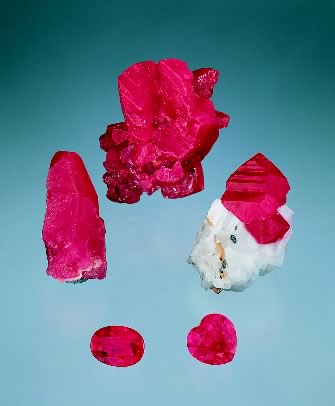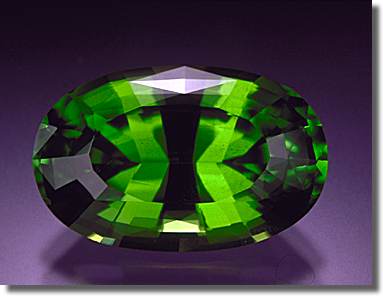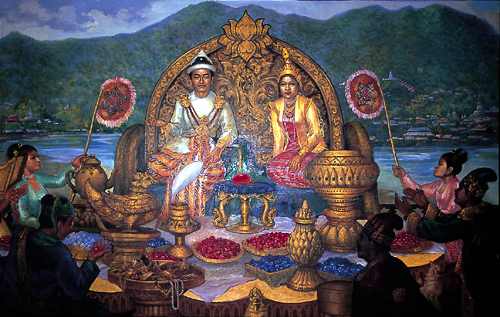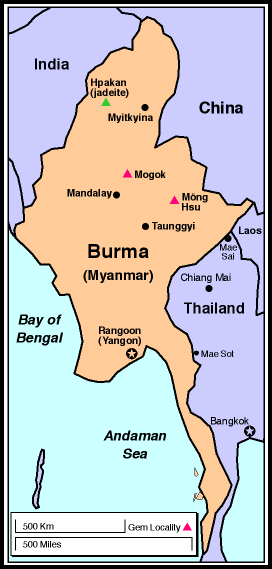|

The Gem Spectrum is Pala International’s
free newsletter. Edited by Pala’s own Gabrièl
Mattice, it is filled with interesting articles on various
aspects of gems and minerals.
We
distribute The Gem Spectrum free
within the United States to members
of the gem and jewelry trades. If
you would like to be added to our mailing
list, please contact us.


 |
| Fine ruby specimens. The crystals
are from, from left to right, Afghanistan, Vietnam
and Tanzania, while the two faceted gems are from
Mogok, Burma. (Photo: Harold & Erica Van Pelt). |
|
Burma,
presently known as Myanmar, is experiencing many changes
which will hopefully lead to a resurgence of supply, and
therefore demand, for its most precious resource; gemstones.
Myanmar has been historically associated with the very finest
rubies and jadeites, as well as some of the best sapphire,
peridot, spinel and numerous other rare gemstones. However,
supply has been limited since Myanmar has managed to keep
itself isolated from global affairs for the past three decades.
Since our first visit in March of 1993, PaIa International
has returned to this enchanted land on numerous occasions
to establish more open relations with Myanma Gems Enterprise
(MGE), as well as independent miners. We have had the honor
of consulting with the Burmese about new techniques for advancing
their primary mining and updating their gemological equipment.
In turn, we are learning from their traditional and practical
experience of gemstone mining. Upon our visits we have managed
to purchase a number of exquisite gems and mineral specimens.
Our
most recent journey to Myanmar in March,
1995, proved that we would be rewarded
for the past two years of patience and
diligence. We were able to return to
the remote mining town of Mogok where
the world’s most famous rubies have
originated for centuries. After attending
the 32nd MGE Gem, Jade, and Pearl Emporium
in the capitol of Yangon (formerly Rangoon),
we flew north to Mandalay, where our
l00 mile (ten hour) cross-country trek
by jeep would begin. We were accompanied
by two armed guards to protect us from dacoits (the
French word for ‘bandits’),
which we might encounter on the way.
Various insurgents posed less of a threat
since our friends are well-known miners
in the area. Following is a brief summary
of Mogok’s fascinating history and
geology, as well as pertinent gemological
information.

MINING IN MOGOK
In my experience, Pala International could
improve Mogok’s underground primary mining
techniques to recover more gemstones by adding
mechanization. While, in terms of their goals,
Burma’s traditional alluvial mining is
quite effective, the most obvious technological
advancement that could be introduced to their
alluvial mining would be the use of a more
technologically efficient riffle system. Many
small gems are missed. However, throughout
Mogok’s history an entire economy has
been supported by allowing individuals to sort
through tailings in order to make a living.
The improvisation and the intelligence of the
local miner is even more impressive since Mogok
is quite isolated from any metropolitan center.
The
Government’s
philosophy
is for conservation
rather than
mass production.
Although the
deputy minister
of mines and
I discussed
mining techniques
and the obvious
possible technological
advances that
could dramatically
increase production,
his belief
was that they
had been mining
for generations
and if they
brought in
too much technology,
Mogok could
be mined out
in a few years.
He had visited
Kanchanaburi,
in Thailand,
where they
had six large
mines employing
thousands of
people. In
only a few
years, all
that remained
was one small
mine,with only
a few people
employed, and
ecological
problems from
large mine
waste. He did
not feel that
was the proper
way to mine
in Mogok. By
continuing
traditional
methods, people
would be employed
for many future
generations.
As I thought
about it, the
logic was compelling.
William Larson |
|
HISTORY
According to legend, Mogok was originally settled by a gang of bandits
banished from Mandalay in the 15th century by the king. They subsequently
discovered rubies in the valley and sent them to the king, who in
return, pardoned the exiles. Fortunately, they decided to stay and
continue searching for more gemstones. Throughout Mogok’s history,
all large rubies were officially the property of the King or the
government. This official decree, though punishable by death if broken,
is said to have to have resulted in the disappearance of many large
rubies (either broken into smaller pieces in order to avoid the decree
or hidden for generations).
Upper
Burma was annexed by the English Empire and placed under India’s
rule in 1886. Streeter & Co. of London formed “Ruby Mines
Ltd.” in 1887 and continued official operation in Mogok until
1925. The arrival of commercial quantities of synthetics, World
War I, and the Great Depression ultimately forced the British to
relinquish control entirely to the Burmese.
Through
traditional but economically effective
methods, practiced for centuries before
the arrival of the British, the Burmese
diligently continued their quest for
gems. This type of mining continued
until government nationalization of
the region in 1962. Mogok has remained
off limits to most visitors for almost
three decades. Liberalization of mining
in Mogok was initiated by the Myanma
Gems Enterprise in 1991, and today
there are many joint-venture, as well
as independent pendent mining operations,
employing more advanced mining techniques
and equipment, thereby improving production
considerably. However, visits by foreigners
to Mogok are not allowed except in
special cases, and mining is restricted
to Myanma citizens and MGE.
GEOLOGY
 The
mountains around Mogok trend north-south and are part of
the eastern Himalayan orogenic system formed by the collision
of the Indian sub-continental plate into the Eurasian continent
40–60 million years ago. This tectonic activity was
the engine for the resulting regional and contact metamorphism
responsible for the ultimate creation of the corundums
mined in the mountain valley of Mogok. Simply put, this
metamorphism resulted in desilication (removal of SiO2)
of the surrounding dolomitic limestone through initial
crystallization of diopside = CaMg(SiO3)3 and
olivine = Mg2SiO4; then subsequently,
spinel = MgAl2O4, thereby allowing
for the crystallization of corundum = Al2O3.
Trace concentrations of the element chromium (Cr) allow
the formation of the ruby variety, while traces
of iron (Fe) and/or titanium (Ti) are responsible for blue
sapphire. After growth in the mother rock, primary crystals
were later transported by water or alluvial erosion to
their present placer positions in the valley where they
are still being mined today. In the past, mining consisted
primarily of removal of overburden by hand to reach the
gem rich gravels known as byon. Efforts to expand
primary tunnel mining are progressing as demand for more
material increases. The
mountains around Mogok trend north-south and are part of
the eastern Himalayan orogenic system formed by the collision
of the Indian sub-continental plate into the Eurasian continent
40–60 million years ago. This tectonic activity was
the engine for the resulting regional and contact metamorphism
responsible for the ultimate creation of the corundums
mined in the mountain valley of Mogok. Simply put, this
metamorphism resulted in desilication (removal of SiO2)
of the surrounding dolomitic limestone through initial
crystallization of diopside = CaMg(SiO3)3 and
olivine = Mg2SiO4; then subsequently,
spinel = MgAl2O4, thereby allowing
for the crystallization of corundum = Al2O3.
Trace concentrations of the element chromium (Cr) allow
the formation of the ruby variety, while traces
of iron (Fe) and/or titanium (Ti) are responsible for blue
sapphire. After growth in the mother rock, primary crystals
were later transported by water or alluvial erosion to
their present placer positions in the valley where they
are still being mined today. In the past, mining consisted
primarily of removal of overburden by hand to reach the
gem rich gravels known as byon. Efforts to expand
primary tunnel mining are progressing as demand for more
material increases.
GEOGRAPHY
Myanmar, located in southeast Asia, is bordered by Thailand and Laos
in the southeast, China in the northeast, Bangladesh and India in
the northwest, and the Bay of Bengal in the southwest. The rainy
season, brought by monsoons from the Indian Ocean, starts in May
and continues through October, making mining virtually impossible
during those months. Mogok lies in the upper Shan Plateau in a mountain
valley at approximately 4,000 feet in elevation and is accessible
only by jeep or helicopter.
GEMOLOGY
 Corundum
crystallizes in the the trigonal system, usually forming
hexagonal blunt prisms (ruby) or steep bipyramid prisms
(sapphire). With a hardness of nine on Mohs’ scale,
corundum is second only to diamond. Its specific gravity
is 4.0, it is doubly refractive and has refractive index
readings of 1.762–1.770 (0.008). Inclusions are common
and often quite valuable in indicating genesis, authenticity,
country of origin, and possible treatments. Identifying
inclusions are tight clusters of rutile needles, and calcite,
apatite, and dolomite crystals. Negative crystals with
two-phase inclusions and well formed rutile needles are
often found in unheated stones. Corundum
crystallizes in the the trigonal system, usually forming
hexagonal blunt prisms (ruby) or steep bipyramid prisms
(sapphire). With a hardness of nine on Mohs’ scale,
corundum is second only to diamond. Its specific gravity
is 4.0, it is doubly refractive and has refractive index
readings of 1.762–1.770 (0.008). Inclusions are common
and often quite valuable in indicating genesis, authenticity,
country of origin, and possible treatments. Identifying
inclusions are tight clusters of rutile needles, and calcite,
apatite, and dolomite crystals. Negative crystals with
two-phase inclusions and well formed rutile needles are
often found in unheated stones.
Spinel
crystallizes in the isometric (cubic)
system, typically forming octahedral
crystals. Its hardness of eight on
Mohs’ scale and lack of cleavage
make spinel an ideal gemstone. Spinel
has a specific gravity 3.60, is singly
refractive and has a refractive index
of 1.718.
Compared
to corundum, spinels contain fewer
inclusions and therefore provide less
information about their origin. Identifying
inclusions include concentrations of
tiny spinel octahedral and hexagonal
crystals of apatite that can assist
in distinguishing natural from synthetic
spinel.
In
addition to corundum and spinel, peridot,
zircon, moonstone, tourmaline, topaz,
diopside, aquamarine, amethyst, danburite
and arguably the rarest of all gem
minerals, painite, are all found in
the Mogok area.
 |
| A stunning example of the quality
of peridot produced in the Mogok area. (Photo: Robert
Weldon) |
|
SALES TIP
Burmese rubies distinguish themselves from most energy response to ultraviolet
excitation from natural daylight or incandescent light. This fluorescence
may be attributed to low iron concentrations; the presence of which
inhibits fluorescence in other rubies. This vibrant “fire from
within” is a useful selling tool. Gem-quality star rubies are
increasingly rare, because high demand for faceted stones is being
met by heat treatment in Thailand to remove the silk necessary for
asterism. The natural, rich, royal-blue color inherent in most Burmese
sapphires, as well as their typically larger sizes, make color and
size the primary attributes of this variety.
Spinels
occur in almost every color of the spectrum although, red, orange and
pink are the most prominent hues available. A properly cut spinel will
exhibit exceptional brilliance, due to its isotropic nature and relatively
high refractive index. Historically, spinels have often been mistaken
for fine rubies. Spinel’s high clarity combined with its brilliance
and durability make it an ideal gemstone for those looking for an affordable
and genuine alternative to corundum.
Peridot,
found just north of Mogok, represents
some of the world’s finest and
largest available. Thus, availability
in larger sizes and its impressive
depth of color are the two main selling
points for this gem.

An excerpt from Dr. Edward Gübelin’s book, Burma – Land
of Pagodas, which is currently being translated to English, quotes
a famous legend as follows:
“One day, the king of
the valley, a grand old eagle, was circling over
his kingdom and searching for a worthy prey. As he
spread his circles ever wider in the shining blue
of the heavens, he suddenly spied on the valley floor
a piece of fresh meat of the color of purest blood
and more enticing than he had ever seen in all his
flights throughout the whole world. There is the
noble food, for which I have been yearning, said
the lord in the air, and plunged down on to his chosen
prey. But his claws, whose sharpness and strength
had hitherto hooked into the thickest skin, could
do nothing against this presumed prey, colored like
a living heart. He kept on attacking – he, the
lord of the valley, accustomed to victory! – but
in vain! He began to fear that age had impaired his
strength, so he ascended into the air to think it
over. He also sought out other prey in order to test
his strength, but left it lying carelessly as soon
as he had convinced himself of his undiminished powers,
in order to renew his attack on the coveted piece
of booty. Finally it dawned on him: this was no piece
of flesh but a hallowed stone, fashioned out of fire
and the blood of Mother Earth. Reverently, the wise
old King of the Birds grasped it and carried it to
the highest summit of the highest mountain – unattainable
to all living beings on this earth. The valley in
which he had found the precious stone was Mogok,
and the stone the first ruby in the world.”
Edward Gübelin
Burma, Land der Pagoden
(Burma – Land of Pagodas)
|

CONGRATULATIONS, MEG!
Two firsts and one second at this year’s AGTA “Cutting
Edge” Competition! We here at Pala are extremely proud of Meg
Berry’s accomplishments in the art of cutting and cutting design.
We are lucky here in that we get to see her quality work on a daily
basis. Many of you have had the good fortune to have stones cut by
Meg, either from our general inventory or by having her custom-cut
a stone for you. Most cutters toil away without ever getting the
recognition they justly deserve; thus the reason for the “Cutting
Edge” Awards.
The
three categories she won were:
- First Place/Gem Category:
Garnet Class: Hessonite – 12.27 ct; round double brilliant
- First Place/Gem Category:
Tourmaline Class: Bi-color – 13.95 ct; soft-ended emerald
cut
- 2nd Place /Category A: Faceting
Bi-color Tourmaline – 49.95 ct; ditrigonal briolette
Succeeding in such a competition requires not only advanced
technical skills – to achieve optimum shape for the color
and species of the material being cut – but also a thorough
understanding of the gem itself by being able to “see” in
the rough what most of us only appreciate after the stone is
finished.
Meg
has honed these skills
to a professional edge
and we congratulate her
as well as all the other
winners of this year’s
competition. From all of
your friends & co-workers
here at Pala we take our
hats off to you on this
most special achievement.
Way
to Go! |

 |
| Mural illustrating Burmese rubies
in the Myanmar Gemstones Museum in Yangon. (Photo:
Edward Boehm) |
|

“Everybody is familiar with the curious
phenomenon that a single slope of a hill will produce a wine
of a delicate and rare bouquet, which no other vineyard in
the same neighborhood or in any other region can equal. And
again, that a particular valley in Cuba will grow a tobacco
of choice aroma which can be equaled in no other spot. So is
it in the mineral world with the best rubies. These have always
been found in the Mogok Valley, in Upper Burma, a valley which
is perhaps two miles long and of an average breadth of about
half a mile. From this small tract have been produced all the
best stones of the finest colour, and in former times one of
the recognized titles of the Kings of Burma was that of ‘Lord
of the Rubies.’”
Francis Stopford – London
1920
The Romance of the Jewel
Within the past two decades, the
gem world has been given an unparalleled wealth of material;
more than at any other time in history. It seems that the
gem world’s interests run in cycles; it’s as if
mother nature waits for our interest to wane before enticing
us with another gem. With Myanmar very much in the spotlight
these days, the interest has come full circle.
It’s
Tuesday afternoon. I walk into our gem
room and glance over to the counter at
a tray of some of the most beautiful
red I’ve seen in a long time. A
second closer look reveals to me that
this is some of the breathtaking treasure
acquired at this year’s annual Myanma
Gem, Jade and Pearl Emporium in Myanmar;
formerly known as Burma. The stones were
delivered via armed courier in a package
that, once selected and purchased, was
waxed and sealed under the watchful eye
of the purchaser, seller and customs
officials. The valuable package was then
shipped with not another person getting
a peek until now.
This
all sounds very dramatic; and romantic
and in actuality... it is. What little
boy hasn’t imagined traveling
off to far away countries, armed bodyguards
at his sides, attempting terrain that
only few have traveled in pursuit of
one sole purpose... the acquiring of
untold treasures. What little girl
hasn’t dreamt of those very same
things? Only, in addition to her dream,
those same treasures are also being
bestowed adoringly upon her.
In
the world of gemstones, geographically
speaking, Burma, particularly Mogok,
is thought of almost reverently. Mother
nature has seen fit to bless this land
with some of the most luscious rubies,
richest sapphires and brilliant spinels
that will stop a girl in her tracks...
at least they have me! When I gaze
upon these incredible creations of
nature, I can’t help but remember
that acquiring them didn’t come
without a considerable degree of risk
and back-breaking labor.
At
the American Gem Society (AGS) Conclave
held this year in Phoenix, I had the
pleasure of sharing dinner with Dr.
Edward Gübelin and chatting about
the differences between Burma, when
he visited the enchanted land in the
early 1960s and then more recently
within the past five years. As he explained
the complexities involved in reaching
Mogok, his eyes lit up when he reminisced
about the generosity and kindness he
received whenever he visited. The Burmese
culture is one of deep respect for
the abundance that nature has bestowed
upon their land. I detected that same
respect in his eyes when he spoke of
the hard work that those same people
endured to recover the fine bounty,
Time evaporated as he talked of how
traveling to what is still considered
the premier source of gem ruby and
how it has remained virtually unchanged
throughout the decades. Our talk reminded
me that many months before that dinner,
I had watched the video Dr. Gübelin
compiled with his daughter, Marie-Helen,
in 1962. The tape is titled Mogok – Valley
of Rubies. In it he details an
entire buying trip, from beginning
to end, including how the mining is
accomplished. There is rare footage
from the I960s in which Burmese miners
employ traditional methods, most of
which are still used today.
I
so enjoyed watching the unusual, rarely
seen methods of negotiation used between
seller and purchaser. I was also pleasantly
surprised to see that the majority
of the daily dealing and decision-making
was actually done by the women.
If
you’ve never had a chance to see
Mogok personally, and how many westerners
have?.. please do yourself a favor
and add this tape to your reference
library. This video is a “must
have.”
After
having watched this incredible film
in all its splendor, I was given a
much greater knowledge and appreciation
for the beauty that I am so privileged
to work with. But Dr. Gübelin,
your genuine passion reaffirms the
romance, and I dare say, no synthetic
process will ever duplicate that.
 |
Gabrièl
Mattice |
|



 Corundum
crystallizes in the the trigonal system, usually forming
hexagonal blunt prisms (ruby) or steep bipyramid prisms
(sapphire). With a hardness of nine on Mohs’ scale,
corundum is second only to diamond. Its specific gravity
is 4.0, it is doubly refractive and has refractive index
readings of 1.762–1.770 (0.008). Inclusions are common
and often quite valuable in indicating genesis, authenticity,
country of origin, and possible treatments. Identifying
inclusions are tight clusters of rutile needles, and calcite,
apatite, and dolomite crystals. Negative crystals with
two-phase inclusions and well formed rutile needles are
often found in unheated stones.
Corundum
crystallizes in the the trigonal system, usually forming
hexagonal blunt prisms (ruby) or steep bipyramid prisms
(sapphire). With a hardness of nine on Mohs’ scale,
corundum is second only to diamond. Its specific gravity
is 4.0, it is doubly refractive and has refractive index
readings of 1.762–1.770 (0.008). Inclusions are common
and often quite valuable in indicating genesis, authenticity,
country of origin, and possible treatments. Identifying
inclusions are tight clusters of rutile needles, and calcite,
apatite, and dolomite crystals. Negative crystals with
two-phase inclusions and well formed rutile needles are
often found in unheated stones. 

